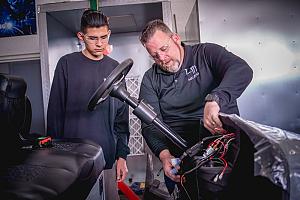- FMA
- The Fabricator
- FABTECH
- Canadian Metalworking
Our Publications
Categories
- Additive Manufacturing
- Aluminum Welding
- Arc Welding
- Assembly and Joining
- Automation and Robotics
- Bending and Forming
- Consumables
- Cutting and Weld Prep
- Electric Vehicles
- En Español
- Finishing
- Hydroforming
- Laser Cutting
- Laser Welding
- Machining
- Manufacturing Software
- Materials Handling
- Metals/Materials
- Oxyfuel Cutting
- Plasma Cutting
- Power Tools
- Punching and Other Holemaking
- Roll Forming
- Safety
- Sawing
- Shearing
- Shop Management
- Testing and Measuring
- Tube and Pipe Fabrication
- Tube and Pipe Production
- Waterjet Cutting
Industry Directory
Webcasts
Podcasts
FAB 40
Advertise
Subscribe
Account Login
Search
Case History: Electrical system manufacturer uses AM to reduce part count in aircraft generator housing
- December 18, 2018
- News Release
- Additive Manufacturing

The Grade 5 titanium housing Betatype 3D-printed consists of a metal foam core and a sandwich-structure outer wall.
Situation
Safran Electrical & Power, Blagnac, France, designs and produces electrical systems for commercial and military aircraft ─ both fixed- and rotary-wing types. With a desire to improve design knowledge and an increasing number of customers requesting parts to be made by additive manufacturing, the company knew it had to enlist an AM design specialist.
The Power Division’s 3D printing team was looking for ways to improve the design of an electrical generator housing and began searching for solutions.
Resolution
“We came across Betatype in a search for 3D printing specialists,” said Dr. Mark Craig, the company’s materials, special processes, and composites expert responsible for coordinating AM within the Power Division. “It was clear after our initial discussions that they had the knowledge and skill set we were looking for to add value in our new part-production program.”
Using 3D printing technology, Betatype was able to improve the design of the electrical generator housing by focusing on a number of key areas: improving strength, increasing stiffness, and reducing overall weight.
Betatype, London, developed a proof of concept using an ultrahigh-density lattice as part of a sandwich structure with more than 10 million elements.
Betatype CEO Sarat Babu said: “We knew creating a more complex, higher-density lattice structure was the key to achieving what Safran was looking for in the part. Applying our technology and multiscale approach, we were able to control the scan path and exposure settings down to each element of the sandwich structure’s design. By pushing the AM process of laser powder bed fusion well beyond its standard processes, we created the ultrahigh-density lattice structure required.”
The proof of concept proved to be a success. Betatype optimized Safran’s generator housings for AM, unifying the design from several complex, machined components into one part. This reduced the overall part count and manufacturing time, adding value and saving costs.
Betatype uses 3D printing to help watchmaker make better bands
In other Betatype activities, the company has collaborated with luxury watchmaker Uniform Wares, Leicester, England, to design sleek, 3D-printed watchbands.
Michael Carr, creative director at Uniform Wares, said, “While we are always taking prompts from heritage and traditional processes, we also like to push things forward.”It was this drive to embrace technological innovations and adopt new materials that led the company to begin working with Betatype. “We were already using 3D printing to develop plastic – and some metal – prototypes,” Carr said. “So, when Betatype got in touch and explained that they could help us to achieve more accurate and intricate designs, we were interested.”
The two companies designed a lightweight, woven titanium watch strap. Betatype built the band with a laser powder-bed-fusion printer. The fabric-like strap incorporates a new type of directional clasp that interlocks with the weave of the strap itself – a design element that could not be achieved using more traditional methods like welding.
More than 4,000 interlocking links form a strong, lightweight structure that weighs just 10.5 grams. Unlike traditional mesh straps, each link is asymmetric, which means each side of the strap behaves differently.
This allows the strap to fit easily over the hand while remaining flexible enough to be secured with the microscopic “teeth” integrated in the inside of the clasp that secures it to the wearer’s wrist.
- Podcasting
- Podcast:
- The Fabricator Podcast
- Published:
- 05/14/2024
- Running Time:
- 62:12
Cameron Adams of Laser Precision, a contract metal fabricator in the Chicago area, joins the podcast to talk...
- Trending Articles
- Industry Events
Laser Welding Certificate Course
- May 7 - August 6, 2024
- Farmington Hills, IL
World-Class Roll Forming Workshop
- June 5 - 6, 2024
- Louisville, KY
Advanced Laser Application Workshop
- June 25 - 27, 2024
- Novi, MI
Precision Press Brake Certificate Course
- July 31 - August 1, 2024
- Elgin,


























